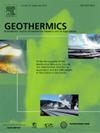From a natural disaster to a geothermal opportunity: The Lusi geothermal system investigated with Ambient Noise Attenuation Tomography
IF 3.9
2区 工程技术
Q3 ENERGY & FUELS
引用次数: 0
Abstract
Lusi, the youngest sediment-hosted geothermal system on Earth, pierced the surface in May 2006 in the Kendeng Basin (East Java). To investigate the subsurface and the fluid migration pathways feeding this large eruptive center we processed a dataset of seismic ambient noise. We compared the intrinsic attenuation distribution and the S-wave velocity structure of a region of the Javanese back-arc basin against its shear wave velocity structure. Our study highlights that Lusi’s plumbing system features two distinct fluid flow regimes, one across the shallow sedimentary units and one developing sub-vertically across the deeper domains of the basin. We show that ambient noise and intrinsic attenuation tomographies are complementary tools that should be performed routinely when studying geothermal systems. For decades, this region has been considered a hydrocarbon province as shown by the dozens of wells extracting hydrocarbons form the reservoirs. However, we instead highlight that such a basin is rich in geothermal resources. In particular, we argue that since the hydrocarbon extraction is declining and the energy transition is becoming imperative, the available hydrocarbon facilities should instead be repurposed for the extraction of geothermal resources. The high geothermal gradient, the steep topography of the nearby volcanic arc driving fluid flow and the well-studied subsurface, make this portion of the Kendeng basin an excellent geothermal site. Furthermore, the abundant geothermal resources at depth could be harnessed by re-purposing the dozens of wells drilled in the depleted oil and gas fields. Future geothermal operators should capitalize on existing infrastructure and turn the Lusi natural disaster into a geothermal opportunity.
从自然灾害到地热机遇:利用环境噪声衰减层析成像技术对芦西地热系统进行了研究
2006年5月,地球上最年轻的沉积地热系统“露西”在东爪哇的肯登盆地穿透地表。为了研究这个大型喷发中心的地下和流体迁移路径,我们处理了一个地震环境噪声数据集。对爪哇弧后盆地某地区的固有衰减分布和横波速度结构进行了对比研究。我们的研究强调了芦西的管道系统具有两种不同的流体流动模式,一种是在浅层沉积单元上,另一种是在盆地深层域中的亚垂直发展。我们表明,在研究地热系统时,环境噪声和固有衰减层析成像是应该常规执行的互补工具。几十年来,该地区一直被认为是一个碳氢化合物省,从储层中提取碳氢化合物的数十口井表明了这一点。然而,我们反而强调这样一个盆地是丰富的地热资源。特别是,我们认为,由于碳氢化合物的开采量正在下降,能源转型变得势在必行,现有的碳氢化合物设施应改为地热资源的开采。高地温梯度、附近火山弧驱动流体流动的陡峭地形以及对地下的充分研究,使这部分盆地成为一个极好的地热场。此外,通过重新利用在枯竭的油气田中钻探的数十口井,可以利用深层丰富的地热资源。未来的地热运营商应该利用现有的基础设施,把露西的自然灾害转化为地热的机会。
本文章由计算机程序翻译,如有差异,请以英文原文为准。
求助全文
约1分钟内获得全文
求助全文
来源期刊

Geothermics
工程技术-地球科学综合
CiteScore
7.70
自引率
15.40%
发文量
237
审稿时长
4.5 months
期刊介绍:
Geothermics is an international journal devoted to the research and development of geothermal energy. The International Board of Editors of Geothermics, which comprises specialists in the various aspects of geothermal resources, exploration and development, guarantees the balanced, comprehensive view of scientific and technological developments in this promising energy field.
It promulgates the state of the art and science of geothermal energy, its exploration and exploitation through a regular exchange of information from all parts of the world. The journal publishes articles dealing with the theory, exploration techniques and all aspects of the utilization of geothermal resources. Geothermics serves as the scientific house, or exchange medium, through which the growing community of geothermal specialists can provide and receive information.
 求助内容:
求助内容: 应助结果提醒方式:
应助结果提醒方式:


